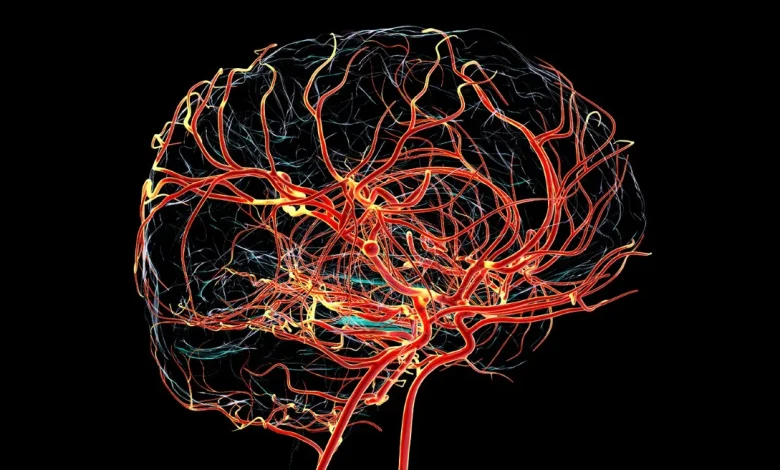Enabling tailored care for China’s ageing society

Stroke occurs when blood vessels in the brain (pictured in this illustration) are blocked, disrupting critical functions. High blood pressure is a major risk factor.Credit: Kateryna Kon/Science Photo Library/Getty
As AI and healthcare become more entwined, a check-up for an older adult in a remote village might begin with a routine eye scan at a local clinic. Images are analysed by an AI tool that not only looks for glaucoma, but also checks cardiovascular risk. Meanwhile, blood-pressure readings, collected continually by smart devices, feed into a real-time health report — enabling a community physician to launch a tailored blood-pressure management plan.
“These are the kinds of advances we can expect, as care for the diseases of ageing shifts from fragmented responses to a systemic, precise and proactive approach,” says Xunming Ji, a neurosurgeon and president of Capital Medical University (CMU) in Beijing, China.
China is home to the world’s largest population of people aged 60 and over — a figure expected to surpass 400 million by 2035. As a result, age-related chronic diseases pose an escalating challenge to the country’s healthcare system. Cardiovascular conditions are particularly prevalent, while vision loss caused by diabetic retinopathy and macular degeneration represents another critical issue.
The goal now is not simply to lengthen lifespan, but to extend healthspan, says Ji. Researchers at CMU are working towards this in many ways, including improving treatments for stroke and blood pressure management, and using AI for early detection of vision loss.
Stroke care
Xunming Ji, president of Capital Medical University, leads research on stroke prevention and translational medicine, including studies on stroke pathogenesis, cerebral blood flow reconstruction and neuroprotection.Credit: Capital Medical University
Stroke, caused by blocked blood vessels in the brain, is a leading cause of death and disability. “Every second after a vessel is blocked, more brain tissue is lost,” says Ji. “The task, therefore, is not only to reopen the arteries, but also to protect the vulnerable brain tissue until blood flow is restored.”
Basilar artery occlusion (BAO), caused by a clot in a major artery at the base of the brain, is particularly lethal. It can damage regions responsible for vital functions and has a mortality rate of almost 80%. Surgical procedures to restore blood flow here are “difficult and risky,” Ji explains.
To improve the odds, his team has designed an integrated treatment for BAO. They use advanced multimodal imaging to pinpoint salvageable brain tissue, and then treat patients with minimally invasive ‘mechanical thrombectomy’, which is a technique to clear a clot. This is often paired with an ‘angioplasty’ procedure to keep the artery open.
Two surgical trials, ATTENTION (within 12 hours of onset) and BAOCHE (within 6–24 hours of onset), were conducted to evaluate patient outcomes when thrombectomy is given during these critical early periods1,2.
“Extending the possibility of treatment out to 24 hours meant that even patients transferred from smaller hospitals could now be considered for intervention that might save their lives,” explains Ji.
However, although blood vessels were successfully reopened in nearly 90% of cases included in the trials, only about 40% of patients regained good long-term brain function. “The artery may be open, but the brain is not always saved,” Ji notes. This is because when a clot blocks blood flow, the surrounding brain tissue begins to deteriorate due to lack of oxygen.
To address this gap between vessel reopening and brain recovery, the team has spent a decade investigating whether supplementary oxygen, delivered via face masks, may help to preserve the brain tissue.
After a promising small trial, dubbed OPENS-1, the team conducted a larger OPENS-2 trial with 280 patients to evaluate whether supplementary oxygen can improve functional outcomes in patients treated with thrombectomy3.
The OPENS-2 trial focused on patients with moderate stroke severity who had received surgery within six hours of the onset of symptoms. Ji’s team is now investigating whether starting oxygen therapy even earlier — such as during ambulance transfer — or extending oxygen supplementation for up to 24 hours after surgery can expand its benefits.
“These efforts are particularly vital for patients in remote areas, where transport delays are inevitable,” says Ji.
Blood pressure
While advances in treatment are vital, preventative care to reduce the burden of stroke is just as important. A significant risk factor is hypertension — affecting more than half of adults aged 60 and above in China, and increasing the risk not only of stroke, but also of heart failure, coronary artery disease and kidney disease.
President of Beijing Anzhen Hospital, Jun Cai (middle) visits patients undergoing intensive treatment for blood pressure control.Credit: Anzhen Hospital
“In daily practice we often see complications first, long before patients realize their blood pressure has been high for years,” says Jun Cai, a cardiologist and president of Beijing Anzhen Hospital affiliated with CMU. “Awareness and control remain far from adequate.”
To clarify how hypertension should be managed, Cai’s team launched the STEP trial, conducted across 42 hospitals and enrolling more than 8,500 patients aged 60 to 80. Participants were randomly assigned to target different systolic blood pressure levels — the top number in a blood pressure reading. The two groups targeted either a standard range of 130 to less than 150 mmHg, or a lower range of 110 to less than 130 mmHg.
After a median follow-up of three years, researchers found the treatment group that had their blood pressure maintained at the lower level had fewer cardiovascular events, especially strokes4.
The results offer valuable insights on how intensive blood pressure control can benefit hypertension patients, but the study has some limitations, says Cai, who adds that: “frailer individuals and those with multiple conditions were not included, follow-up was relatively short, and all participants were Chinese.”
To explore whether earlier intervention provides greater protection, the team recently launched the STEP pre-trial, examining whether initiating treatment before hypertension fully develops can reduce long-term cardiovascular risk. It is now enrolling about 25,000 participants with high-normal blood pressure (130–139/80–89 mmHg, based on the diagnostic criteria in China) across 165 hospitals.
Cai’s team is also working to better understand the mechanisms behind persistent high blood pressure. They identified a cell membrane protein called GPR146, which helps cells detect the pressure of blood flowing through vessels. GPR146 interacts with the PIEZO1 ion channel to convert mechanical stress into chemical signals inside the cell. Together, these components appear to trigger changes in blood vessels — known as vascular remodelling — that can lead to increased blood pressure over time5.
“We are now studying whether this pathway might be targeted with treatments,” Cai says. “Clinical studies tell us how to manage patients, but mechanistic research shows us where new interventions might emerge.”
Approaches such as small nucleic acids, gene-based modulation, preventive vaccines, and even regenerative therapies might hold promise to reshape how hypertension will be treated, he says.
Eye screening
The importance of managing hypertension extends beyond reducing cardiovascular risk — it also plays a critical role in preserving eye health as we age.
The ophthalmic AI research team at Beijing Tongren Eye Center, including centre director Ningli Wang (second from left).Credit: Beijing Tongren Hospital
“Today, not only do age-related ocular pathologies such as glaucoma, macular degeneration, and cataracts pose threats to visual health, but eye conditions associated with chronic systemic diseases are also emerging as major causes of vision loss,” says Ningli Wang, director of Beijing Tongren Eye Center at Beijing Tongren Hospital, affiliated with CMU.
Wang emphasizes that many of these conditions can be effectively managed if detected early. But the challenge lies in screening millions of people cost-effectively.
His team found that screening for a single eye disease was prohibitively expensive, but combining screening for five major causes of blindness was very cost-effective6. They compared traditional in-person screening, telemedicine, and AI-assisted telemedicine for detecting multiple age-related blinding eye diseases. “We found the AI-assisted model can reduce cost and improve access, especially in underserved rural areas,” says Wang.
These findings spurred the creation of VisionFM, a multimodal vision foundation model co-developed with the Chinese University of Hong Kong7. The model was pre-trained on data from 560,000 people and 3.4 million ophthalmic images, which covered eight common imaging methods such as fundus photography and optical coherence tomography. VisionFM can solve multiple ophthalmic tasks, including ocular disease screening and progression prediction.
Wang says the tool can further benefit clinical practice, through digital sharing of images across hospital networks, facilitating improved remote consultations.
The team is now piloting the model in community clinics and mobile health vans. They found that after it was trained with paired retinal images and blood tests datasets, the model could also predict systemic health markers, such as blood counts, renal function, blood glucose and lipids, with an average accuracy close to 80%.
“The eye is an organ that allows non‑invasive, direct observation of nerves, blood vessels and even changes in blood flow,” Wang explains. “That’s why it can reveal so much about the rest of the body — and our aim is early detection, not only for eye disease, but also for the chronic conditions that threaten our independence in older age.”
Smarter health
According to Ji, the key lies in building a nationwide ‘smart health network’ that spans prevention, screening, diagnosis, treatment and rehabilitation, and which connects national centres all the way to a patient’s home.
“Making this system work requires new ways to share knowledge,” he says. “AI models like VisionFM must learn from data across the country, but we also need clear regulations and standard procedures to safeguard privacy.”
Ultimately, the success of the system relies on a new generation of scientists. “The breakthroughs we need will come from people who can stand at the patient’s bedside and work at the lab bench,” says Ji. “And they must collaborate. Progress depends on bringing together clinicians, basic scientists, engineers and data experts to tackle the same clinical problems.”





